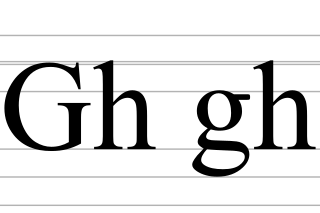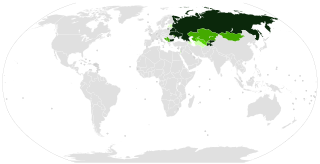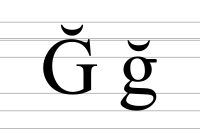
A diacritic is a glyph added to a letter or to a basic glyph. The term derives from the Ancient Greek διακριτικός, from διακρίνω. The word diacritic is a noun, though it is sometimes used in an attributive sense, whereas diacritical is only an adjective. Some diacritics, such as the acute ⟨ó⟩, grave ⟨ò⟩, and circumflex ⟨ô⟩, are often called accents. Diacritics may appear above or below a letter or in some other position such as within the letter or between two letters.

A breve is the diacritic mark ◌̆, shaped like the bottom half of a circle. As used in Ancient Greek, it is also called brachy, βραχύ. It resembles the caron but is rounded, in contrast to the angular tip of the caron. In many forms of Latin, ◌̆ is used for a shorter, softer variant of a vowel, such as "Ĭ", where the sound is nearly identical to the English /i/.

Tatar is a Turkic language spoken by the Volga Tatars mainly located in modern Tatarstan, as well as Siberia. It should not be confused with Crimean Tatar or Siberian Tatar, which are closely related but belong to different subgroups of the Kipchak languages.
A labialized velar or labiovelar is a velar consonant that is labialized, with a -like secondary articulation. Examples are, which are pronounced like a, with rounded lips, such as the labialized voiceless velar plosive and labialized voiced velar plosive, obstruents being common among the sounds that undergo labialization.

A digraph or digram is a pair of characters used in the orthography of a language to write either a single phoneme, or a sequence of phonemes that does not correspond to the normal values of the two characters combined.

Ge, ghe, or he is a letter of the Cyrillic script. Most commonly, it represents the voiced velar plosive, like ⟨g⟩ in "gift", or the voiced glottal fricative, like ⟨h⟩ in "heft". It is generally romanized using the Latin letter g or h, depending on the source language.

Crimean Tatar, also called Crimean, is a Kipchak Turkic language spoken in Crimea and the Crimean Tatar diasporas of Uzbekistan, Turkey and Bulgaria, as well as small communities in the United States and Canada. It should not be confused with Tatar, spoken in Tatarstan and adjacent regions in Russia; the two languages are related, but belong to different subgroups of the Kipchak languages, while maintaining a significant degree of mutual intelligibility. Crimean Tatar has been extensively influenced by nearby Oghuz dialects and is also mutually intelligible with them to varying degrees.

Kumyk is a Turkic language spoken by about 520,000 people, mainly by the Kumyks, in the Dagestan, North Ossetia and Chechen republics of the Russian Federation. Until the 20th century Kumyk was the lingua franca of the Northern Caucasus.
The Common Turkic alphabet is a project of a single Latin alphabet for all Turkic languages based on a slightly modified Turkish alphabet, with 34 letters recognised by the Organization of Turkic States.
Ayin is the sixteenth letter of the Semitic scripts, including Phoenician ʿayin 𐤏, Hebrew ʿayinע, Aramaic ʿē 𐡏, Syriac ʿē ܥ, and Arabic ʿaynع.
Compensatory lengthening in phonology and historical linguistics is the lengthening of a vowel sound that happens upon the loss of a following consonant, usually in the syllable coda, or of a vowel in an adjacent syllable. Lengthening triggered by consonant loss may be considered an extreme form of fusion. Both types may arise from speakers' attempts to preserve a word's moraic count.

Ch is a digraph in the Latin script. It is treated as a letter of its own in the Chamorro, Old Spanish, Czech, Slovak, Igbo, Uzbek, Quechua, Ladino, Guarani, Welsh, Cornish, Breton, Ukrainian Latynka, and Belarusian Łacinka alphabets. Formerly ch was also considered a separate letter for collation purposes in Modern Spanish, Vietnamese, and sometimes in Polish; now the digraph ch in these languages continues to be used, but it is considered as a sequence of letters and sorted as such.

The letter Ƣ has been used in the Latin orthographies of various, mostly Turkic languages, such as Azeri or the Jaꞑalif orthography for Tatar. It is also included in pinyin alphabets for Kazakh and Uyghur; and in the 1928 Soviet Kurdish Latin alphabet. It usually represents a voiced velar fricative but is sometimes used for a voiced uvular fricative. All orthographies that used the letter have been phased out and so it is not well-supported in fonts. It can still be seen in pre-1983 books published in the People’s Republic of China.

⟨Ǧ⟩, called "G with caron", is a letter used in several Latin orthographies.
The Arabic letter غ is one of the six letters the Arabic alphabet added to the twenty-two inherited from the Phoenician alphabet. It represents the sound or. In name and shape, it is a variant of ʻayn. Its numerical value is 1000. In the Persian language, it represents ~ and is the twenty-second letter in the new Persian alphabet.

Gh is a digraph found in many languages.

Ge with stroke is a Cyrillic letter which represents the letter Г with a horizontal stroke. It is used in the Bashkir, Kazakh Cyrillic and Uzbek Cyrillic alphabets where it represents a voiced uvular fricative. Despite having a similar shape, it is not related to the F of the Latin alphabet. In Kazakh, this letter may also represent the voiced velar fricative. In the Uzbek Latin alphabet, this letter corresponds to Gʻ.

Numerous Cyrillic alphabets are based on the Cyrillic script. The early Cyrillic alphabet was developed in the 9th century AD and replaced the earlier Glagolitic script developed by the theologians Cyril and Methodius. It is the basis of alphabets used in various languages, past and present, Slavic origin, and non-Slavic languages influenced by Russian. As of 2011, around 252 million people in Eurasia use it as the official alphabet for their national languages. About half of them are in Russia. Cyrillic is one of the most-used writing systems in the world. The creator is Saint Clement of Ohrid from the Preslav literary school in the First Bulgarian Empire.
Crimean Tatar is written in both Latin and Cyrillic. Historically, the Persian script was also used.













